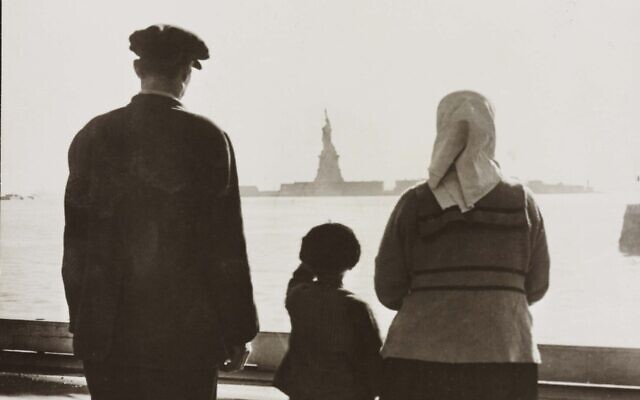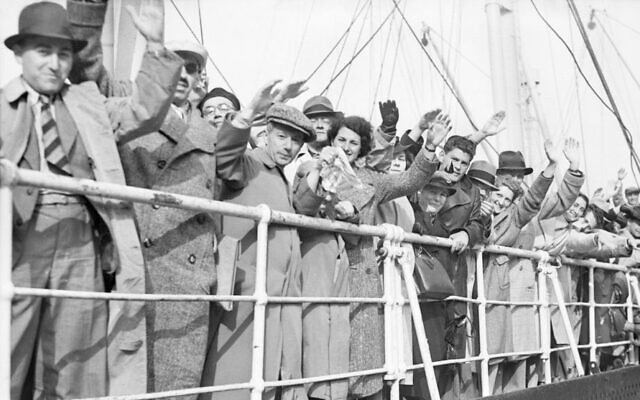NEW YORK — “It’s not one of the things that will go down in the long annals of good things America did. It goes in a different book,” says Prof. Deborah Lipstadt, forever the voice of reason, coming to terms with something nobody wants to hear — and that she undoubtedly wishes she did not have to say.
She’s speaking about the American response to — and, in some ways, even its shared culpability in — the Holocaust.
“That’s absurd,” you might think. “How is this America’s fault? They were across the ocean, minding their own business, and when the time came they landed at Normandy and helped liberate Europe!”
Yes, this is true. But we’re discussing a Ken Burns documentary, which means we are at the adult table now, not on Twitter where everything is blanched of nuance and reduced to a sharp quip meant to make other people look dumb. For a story as staggering as the Holocaust, we must look at it honestly, and from every angle. “Never again” is meaningless if we can’t analyze everything.
When I first heard that Ken Burns made a documentary about the Holocaust, my first thought, I’ll admit, was, “If he hasn’t done it already, why bother now?” Burns, who became a titan in his field with his 1990 release “The Civil War” (which I once called the greatest American documentary), and his company Florentine Films, have been pumping out very distinctive information-rich television events since the early 1980s and have covered a number of heavy topics from an American perspective.
In addition to works about American icons like Thomas Jefferson, Benjamin Franklin, and the Brooklyn Bridge, Burns has covered cultural subjects with “Jazz” and “Country Music,” “Baseball,” and more troubling subject matter, with his films “The Central Park Five” and “The Vietnam War.” He could have set his camera to the Holocaust at any time, but, in a weird way, it’s fortunate that he waited.
Director Ken Burns in a panel discussion during the Television Critics Association Summer Press Tour, July 29, 2019, in Beverly Hills, California. (Photo by Chris Pizzello/Invision/AP, File)
Over three episodes (each a little over two hours) in “The U.S. and the Holocaust,” Burns, with co-directors Lynn Novick and Sarah Botstein, express in very clear terms the litany of indirect actions (or, in many cases, deliberate inaction) which eventually culminated in the murder of six million Jews.
It’s jam-packed, and loaded with personal stories (some from Anne Frank’s eventual stepsister) whose specificity give shading to the larger issues. It’s not pleasant to think about, and it’s understandable to get defensive, but Burns and company are not Molotov cocktail-throwing radicals looking to push buttons. Theirs is, as ever, a calm, thorough approach, and it is very convincing.
Some points are more steeped in history than others. Adolf Hitler, it is documented, was greatly inspired by America’s Jim Crow laws when thinking about how to restrict the rights of Jews in Germany. He drew inspiration from Manifest Destiny, and how American Indians were removed from their land by rotten treaties and placed in reservations.

An immigrant family looking at the Statue of Liberty from Ellis Island, circa 1930. (Library of Congress)
Many eugenics theories emerged from the United States, and people such as Madison Grant, considered a great activist of the Progressive Era, popularized barbaric beliefs and helped spawn a race-based xenophobia that radically changed the country’s immigration policy. Henry Ford, the beloved industrialist, held antisemitism as his favorite hobby, publishing conspiracy texts and fanning the flames of hate. (As I look out my window I can see a Ford vehicle parallel parked in front of my Queens, New York, apartment. You watch this documentary with quotes from Ford and wonder how, at a time when so many historical statues are being torn down, a self-respecting company could still bear that name.)
This background material is presented in the typical Burns manner — a few contemporary commentators, a sober narrator with a flat American accent (Peter Coyote, in this case), shots of photographs, often panning or zooming within that image, and actors reading from primary sources and punctuating them by giving the name of the author. (The closest thing the series has to a joke is when viewers hear beloved German film director Werner Herzog’s inimitable voice about three hours in as Hermann Göring.)
Watching this lengthy series makes one go from unease to frustration to spitting fury as the abominations of the Nazis get more brutal. What I “liked” is how Burns never keeps his eye off the ball of his central premise: This isn’t the Holocaust, this is “The U.S. and the Holocaust,” so every action by the Germans is counterbalanced by how the White House and the American public reacted. And sadly, most Americans, even some American Jews, chose to do nothing. Poll after poll revealed the sad truth: helping Jews was not a priority. In fact, it was unpopular.
Stories of restricted visas are well known, but learning that the red tape was put there deliberately is added salt on the wound. Breckinridge Long, who I guess we’d call a “deep state” worker today, was a lifetime bureaucrat who had an enormous influence in preventing refugees from seeing asylum. His is a shocking story of how one person can have such a devastating impact on so many, and basically get away with it. Learning about his actions will make you want to punch the wall (but it is too easy to lay all the blame at his feet).
What struck me was coming to terms with the following realization: If you look at the initial Nazi goal — killing the world’s Jews — while possibly a dream, was certainly so vast of a chore it seemed ridiculous. They just wanted them out of their lands. The paradox came when they kept expanding, particularly to the East, where so many Jews lived, and found that no one else would take them. Fine, the Nazis said, as they gathered at the Wannsee Conference. If no one else will take them, I guess we’ll just have to kill them.
I’m painting in broad strokes here, but what makes “The U.S. and the Holocaust” such a success for me is that this basic equation about our tragedy is something I’ve known for years, but its plain absurdity never fully hit me until now.
The important works about the Holocaust do that; Claude Lanzmann’s “Shoah” and subsequent films, books like Jean-François Steiner’s “Treblinka,” even fiction like “Schindler’s List” can take something you already know, but present it with new shading that feels revelatory. For Americans, this new film is that important. For Americans who don’t know about the Riegner Telegram or the Karski Reporteven more so.

German Jewish refugees aboard the MS St. Louis, June 29, 1939. (Public domain)
As with any examination of the Holocaust, we in the present can look at Europeans turning their backs on their Jewish neighbors and say, “Oh, that would never be me.” Keep fooling yourself. Stanley Milgram debunked that little fairy tale in the early 1960s. The timeliness of this all, and why it is “good” the series is out right now, is that violent prejudice against Jews, post-Charlottesville, post-Tree of Life, is not merely academic in America.
This isn’t just me pontificating, this is the message Burns and his co-directors hammer home in the final episode, along with an examination of paradoxes in the human psyche. The worst elements of the MAGA and QAnon movements are riddled with antisemites as bad as any from history, yet they support a politician whose most trusted advisor and son-in-law is Jewish. This makes absolutely no sense but, as Deborah Lipstadt points out, neither does antisemitism. As she frames it, they think Jews are all greedy capitalists, but they are also all instigating communists. How can it be both?
It’s ridiculous, of course, but that’s less important than addressing the fact that, somehow, the accusations stick and antisemitism grows. It is critical that artists and historians like Ken Burns, Lynn Novick, and Sarah Botstein use their skills to rouse people to recognition before it is too late. There is a lot of “content” pumped out into the world each week, but Burns still draws a big crowd. “The U.S. and the Holocaust” is essential viewing.